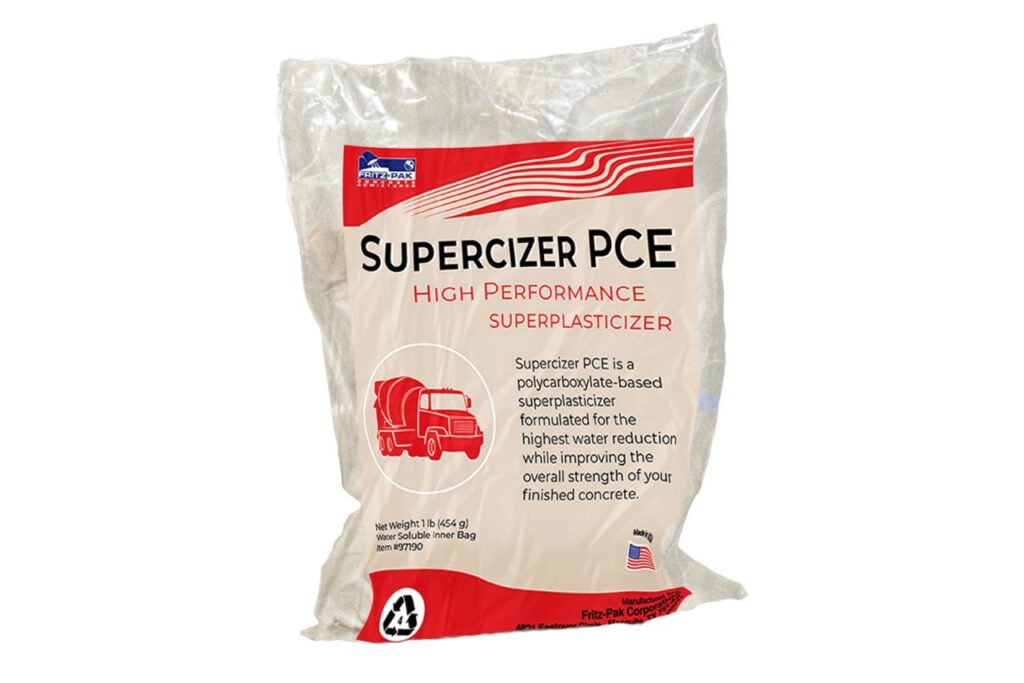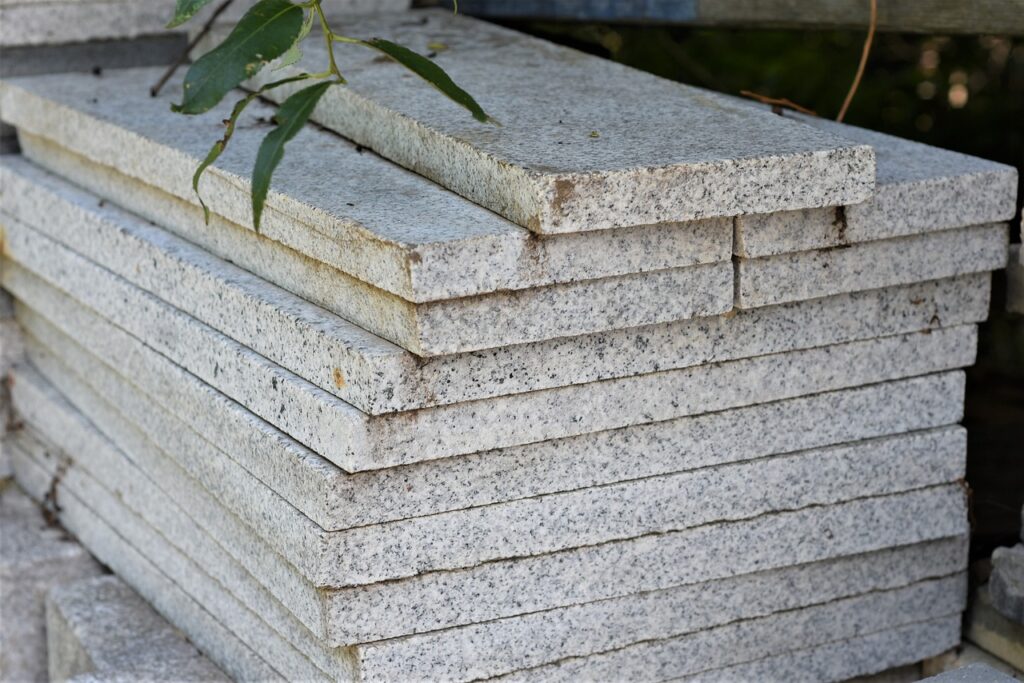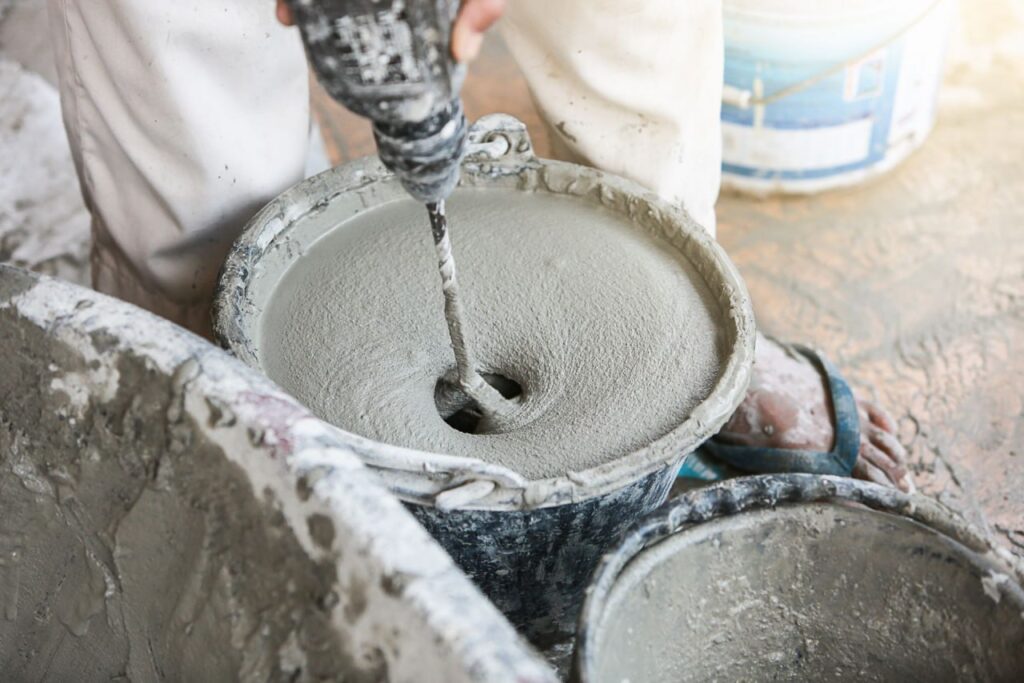Welcome to our comprehensive guide on superplasticizers and their impact on concrete. Concrete stands as a cornerstone in the construction world, vital for creating durable and reliable structures. However, achieving the perfect concrete mix requires more than cement, water, and aggregates. This is where superplasticizers come into play. These remarkable chemical admixtures revolutionize concrete properties, enhancing its workability, strength, and durability without increasing the water content. Whether you’re a construction professional, a DIY enthusiast, or simply curious about the intricacies of concrete technology, this article will demystify the role of superplasticizers and highlight their significance in modern construction practices.
Superplasticizers are chemical admixtures added to concrete to enhance its workability and fluidity without increasing the water content. They help produce high-strength concrete with improved durability and reduced water-cement ratios, making them essential for advanced construction projects and achieving high-performance concrete mixes.
- Understanding Superplasticizers
- The Role Of Superplasticizers In Concrete
- Benefits Of Using Superplasticizers In Concrete
- Applications Of Superplasticizer Concrete
- Practical Considerations
- Case Studies And Real-World Examples
- Common Misconceptions And Challenges
- Future Trends In Concrete Technology
- FAQs: About What Does Superplasticizer Do To Concrete
- Conclusion
- Find A Professional Concrete Company Near You!
Understanding Superplasticizers
Superplasticizers, also known as high-range water reducers, are a class of chemical admixtures used in concrete to enhance its workability and strength. These additives are particularly beneficial in reducing the water content of concrete without compromising its consistency, making it more fluid and easier to handle.
Definition
Superplasticizers are composed of various chemical compounds, typically including sulfonated melamine-formaldehyde condensates, sulfonated naphthalene-formaldehyde condensates, and modified lignosulfonates. These chemicals function by dispersing cement particles, which helps in reducing the water requirement of the mix. This results in a higher strength and more durable concrete. By incorporating superplasticizers, the concrete mix achieves greater fluidity, facilitating easier placement and compaction without the need for additional water. This is particularly advantageous in applications requiring high-performance concrete with enhanced mechanical properties.
History and Development
The development of superplasticizers dates back to the 1960s and 1970s when the construction industry sought innovative solutions to improve the performance of concrete. The initial research and experimentation focused on enhancing concrete workability and strength, leading to the discovery of these powerful admixtures.
The first generation of superplasticizers, primarily based on sulfonated melamine-formaldehyde and sulfonated naphthalene-formaldehyde, revolutionized concrete technology by allowing for significant water reduction while maintaining a workable mix. These early formulations were crucial in constructing high-rise buildings, bridges, and other infrastructure projects that demanded superior strength and durability.
As the construction industry evolved, so did the technology behind superplasticizers. In the late 20th and early 21st centuries, new generations of superplasticizers were developed, incorporating polycarboxylate ethers (PCEs). These advanced superplasticizers offered even greater efficiency in dispersing cement particles, resulting in concrete mixes with exceptional fluidity and reduced water content.
The continuous development and refinement of superplasticizers have played a pivotal role in modern concrete construction. Today, these admixtures are indispensable in creating high-performance concrete for a wide range of applications, from skyscrapers to intricate architectural designs.
In summary, superplasticizers are essential in contemporary concrete technology. Their ability to improve workability, strength, and durability has made them a cornerstone of modern construction practices. Understanding their chemical composition and historical development highlights their significance in advancing concrete technology and meeting the ever-evolving demands of the construction industry.
By grasping the fundamentals of superplasticizers, one can appreciate their critical role in shaping the future of construction, ensuring structures that are not only strong and durable but also environmentally sustainable and cost-effective.

The Role Of Superplasticizers In Concrete
Superplasticizers play a crucial role in the modern construction industry by significantly enhancing the properties of concrete. Understanding their mechanism of action and the various types available can help in selecting the right one for your construction needs.
Mechanism of Action
Superplasticizers, also known as high-range water reducers, are chemical admixtures added to concrete to improve its flow and workability without compromising its strength. At the molecular level, superplasticizers work by dispersing cement particles within the mix. Cement particles tend to cluster together due to electrostatic forces and hydrogen bonding. Superplasticizers contain long-chain molecules that are adsorbed onto the surface of these cement particles, imparting a negative charge to them. This electrostatic repulsion, known as the steric hindrance effect, forces the cement particles to repel each other, thereby breaking up clusters and dispersing them more evenly throughout the mix.
This dispersion effect reduces the viscosity of the concrete, making it more fluid and easier to work with. As a result, less water is required to achieve the desired workability. Reducing the water-cement ratio in concrete enhances its strength and durability while also minimizing potential issues like shrinkage and cracking. The ability of superplasticizers to improve flow properties allows for the production of high-performance concrete with superior mechanical properties.
Types of Superplasticizers
There are several types of superplasticizers, each with distinct chemical compositions and effects on concrete. The most common types include:
- Sulfonated Melamine-Formaldehyde Condensates (SMF): These superplasticizers are known for their high water-reducing capabilities and rapid strength gain. SMF superplasticizers are particularly effective in precast concrete applications where early strength development is critical. They work by adsorbing onto cement particles and creating a strong electrostatic repulsion, leading to improved dispersion and fluidity.
- Sulfonated Naphthalene-Formaldehyde Condensates (SNF): Similar to SMF, SNF superplasticizers are also high-range water reducers that provide excellent workability and strength development. They are often used in ready-mix concrete and high-performance concrete applications. SNF superplasticizers are effective in reducing water content while maintaining a high level of workability, making them suitable for large-scale construction projects.
- Polycarboxylate Ethers (PCE): These are the latest generation of superplasticizers and are highly efficient at reducing water content. PCE superplasticizers work by a combination of electrostatic repulsion and steric hindrance, providing a more controlled and prolonged dispersion effect. This results in exceptional flow properties and longer workability retention, making them ideal for self-consolidating concrete (SCC) and other advanced concrete applications. PCE superplasticizers are also known for their ability to enhance the durability and sustainability of concrete.
- Lignosulfonates: Although not as powerful as SMF or SNF, lignosulfonates are still widely used due to their cost-effectiveness and ability to improve workability. They are derived from wood processing and work by dispersing cement particles through a combination of electrostatic repulsion and hydration effects. Lignosulfonates are often used in low to medium-strength concrete applications where cost considerations are a priority.
By understanding the specific benefits and applications of each type of superplasticizer, construction professionals can make informed decisions to optimize concrete performance for their particular projects. The use of superplasticizers not only improves the workability and strength of concrete but also contributes to more sustainable construction practices by reducing the overall water and cement content needed. This, in turn, leads to a reduction in the carbon footprint of concrete production, aligning with the industry’s growing emphasis on environmental sustainability.

Benefits Of Using Superplasticizers In Concrete
Improved Workability
Superplasticizers are remarkable additives that significantly enhance the workability of concrete. These chemical compounds increase the fluidity of the concrete mix, making it easier to pour and shape without adding extra water. This improved workability is crucial for complex construction projects where precise application and smooth finishes are required. By reducing the viscosity of the concrete, superplasticizers allow for easier handling, better surface finishes, and less segregation of the mix. This means that workers can achieve the desired consistency and flow, ensuring the concrete fills the formwork and encapsulates any reinforcing materials without gaps or voids.
Increased Strength
One of the standout benefits of superplasticizers is their ability to increase the strength of concrete. Traditional concrete mixtures rely heavily on water to achieve the necessary workability, but this can compromise the strength of the final product. Superplasticizers, however, reduce the need for excess water. This lower water content results in a higher water-cement ratio, which is a critical factor in determining the strength of concrete. With superplasticizers, concrete achieves a denser and more cohesive structure, enhancing its compressive strength. This means structures can bear heavier loads and withstand more significant stresses, contributing to the longevity and safety of the construction.
Enhanced Durability
Durability is a key factor in the longevity of concrete structures, and superplasticizers play a vital role in enhancing this property. By reducing the water content in the mix, superplasticizers help create denser, less porous concrete. This decrease in porosity significantly reduces the likelihood of water and other harmful substances penetrating the concrete, which can lead to deterioration over time. Additionally, the improved workability and consolidation of the mix mean fewer air voids and better coverage of reinforcement bars, protecting them from corrosion. Consequently, structures built with superplasticized concrete are more resistant to weathering, chemical attacks, and abrasion, ensuring they remain robust and functional for longer periods.
Reduced Water-Cement Ratio
The water-cement ratio is a critical parameter in concrete mix design, influencing both the workability and the ultimate strength of the concrete. Superplasticizers enable a substantial reduction in this ratio without compromising the mix’s fluidity. Lowering the water-cement ratio enhances the concrete’s mechanical properties, including its compressive strength and modulus of elasticity. This reduction also minimizes the risk of shrinkage and cracking, which can occur when excess water evaporates from the mix. By achieving the desired consistency with less water, superplasticizers ensure that the concrete develops a more compact and durable matrix, leading to improved performance and longevity of the structure.
In summary, the use of superplasticizers in concrete offers multiple benefits that are crucial for modern construction projects. From improving workability and increasing strength to enhancing durability and reducing the water-cement ratio, these additives help create superior concrete mixes that meet the demanding standards of today’s construction industry. Incorporating superplasticizers into your concrete mix can lead to stronger, more durable structures that stand the test of time.

Applications Of Superplasticizer Concrete
Ready-Mix Concrete
Superplasticizers are essential in the ready-mix concrete industry, offering significant advantages for a wide range of construction projects. Ready-mix concrete is a versatile building material delivered in a freshly mixed and unhardened state. The use of superplasticizers in this context enhances workability and fluidity without increasing the water-cement ratio, ensuring high strength and durability. This is particularly beneficial for projects requiring complex formworks or where concrete needs to be pumped over long distances or heights. The improved flowability allows for easier placement and compaction, reducing the risk of voids and ensuring a dense, uniform finish. Additionally, superplasticizers help maintain the concrete’s workability over extended periods, making them ideal for large-scale constructions where timing is crucial.
Precast Concrete
In the precast concrete industry, superplasticizers play a pivotal role in enhancing production efficiency and product quality. Precast concrete components are manufactured in a controlled environment, allowing for precise control over the mix design. By incorporating superplasticizers, manufacturers can achieve higher fluidity, which enables the concrete to flow easily into intricate molds without segregation. This results in superior surface finishes and consistent quality across batches. Moreover, the reduced water content, enabled by superplasticizers, leads to higher early strength development, allowing for quicker demolding and faster production cycles. The enhanced workability also minimizes the need for vibration, reducing labor costs and improving the working conditions within the manufacturing plant.
High-Performance Concrete
High-performance concrete (HPC) and self-compacting concrete (SCC) are specialized forms of concrete that benefit significantly from the use of superplasticizers. HPC is designed to provide superior mechanical properties and durability, often used in demanding environments such as high-rise buildings, bridges, and marine structures. Superplasticizers enable HPC to achieve the required strength with lower water content, enhancing durability and resistance to aggressive environmental conditions. SCC, on the other hand, is characterized by its ability to flow and compact under its weight, eliminating the need for mechanical vibration. Superplasticizers are crucial in SCC formulations, providing the necessary fluidity and stability to ensure complete filling of formworks and encapsulation of reinforcement. This results in high-quality finishes, reduced labor, and faster construction times, making SCC an attractive option for complex and labor-intensive projects.
By leveraging the benefits of superplasticizers, the construction industry can achieve higher efficiency, improved quality, and enhanced performance across a wide range of concrete applications. These advancements contribute to the development of more sustainable and durable infrastructure, meeting the ever-increasing demands of modern construction.

Practical Considerations
Dosage and Mixing
When it comes to the application of superplasticizers in concrete, getting the dosage and mixing just right is crucial for achieving the desired properties. Superplasticizers are typically added in dosages ranging from 0.5% to 3% by weight of the cement. However, the exact amount can vary based on the specific product and the requirements of the concrete mix.
To ensure effective mixing, superplasticizers should be added to the concrete after the initial mixing of the other ingredients. This step-by-step process involves first mixing the cement, aggregates, and water. Once a homogeneous mix is achieved, the superplasticizer is introduced. It’s essential to continue mixing the concrete for a few additional minutes after adding the superplasticizer to ensure it is evenly distributed throughout the mix.
Compatibility with Other Admixtures
Compatibility is a key factor when using superplasticizers alongside other concrete admixtures. While superplasticizers can be used in combination with other admixtures like accelerators, retarders, and air-entraining agents, careful consideration is required to avoid adverse interactions.
Before combining superplasticizers with other admixtures, conducting compatibility tests is recommended. These tests help identify any potential issues, such as reduced effectiveness or undesirable chemical reactions. It’s important to follow the manufacturer’s guidelines and consult with a concrete technologist to ensure the admixtures work harmoniously together. Proper sequencing of adding these admixtures during the mixing process is also critical to achieving optimal results.
Environmental Impact
Using superplasticizers in concrete not only enhances the performance and workability but also offers notable environmental benefits. One of the primary advantages is the reduction in water usage. By enabling lower water-cement ratios, superplasticizers contribute to the creation of more durable concrete structures with reduced permeability, thereby extending the lifespan of concrete and minimizing the need for repairs and replacements.
Additionally, superplasticizers can help reduce the overall carbon footprint of concrete production. By improving the flow and workability of concrete, they allow for the use of supplementary cementitious materials (SCMs) such as fly ash, slag, and silica fume. These SCMs can partially replace cement, which is a major source of CO2 emissions in concrete production. Moreover, the enhanced durability of concrete made with superplasticizers can lead to longer-lasting structures, further contributing to sustainability by reducing the frequency and extent of maintenance and reconstruction activities.
Overall, the thoughtful application of superplasticizers in concrete can significantly contribute to sustainable construction practices, making them a valuable component in the pursuit of greener building solutions.

Case Studies And Real-World Examples
Case Study 1: Transforming a Major Construction Project with Superplasticizers
In the bustling city of Wellington, New Zealand, a major construction project was underway to build a state-of-the-art commercial complex. This project, known as Wellington Business Hub, faced numerous challenges due to the complexity and scale of the design. One of the primary concerns was ensuring the concrete used could flow easily into intricate mold designs while maintaining high strength and durability.
- Challenge: The project demanded a concrete mix that could be poured into tight spaces without compromising the structural integrity. Traditional concrete mixes were proving insufficient as they either hardened too quickly or lacked the necessary fluidity to fill the complex molds.
- Solution: The engineering team decided to incorporate superplasticizers into the concrete mix. Superplasticizers are high-range water reducers that significantly improve the workability of concrete without adding extra water. By adding superplasticizers, the team was able to achieve a highly fluid and workable concrete mix that could easily flow into intricate designs without segregating or losing strength.
- Outcome: The use of superplasticizers transformed the project. The concrete maintained its high strength and durability, crucial for the structural integrity of the commercial complex. Additionally, the enhanced workability reduced labor time and costs, as the concrete could be placed more efficiently and accurately. The project was completed on time and within budget, showcasing the vital role of superplasticizers in modern construction projects.
Case Study 2: Enhancing Durability and Longevity in Residential Construction
In the suburban area of Christchurch, a large-scale residential development aimed to build a sustainable and long-lasting neighborhood. The developers wanted to ensure that the houses not only met current building standards but also offered enhanced durability to withstand the region’s seismic activity.
- Challenge: The primary challenge was to create a concrete mix that could provide superior strength and durability without compromising on workability. The region’s seismic activity required concrete that could offer flexibility and robustness, ensuring the houses could withstand potential earthquakes.
- Solution: The construction team opted for a concrete mix enriched with superplasticizers. By integrating superplasticizers, the team could reduce the water-cement ratio significantly. This reduction was critical in achieving a denser, more durable concrete that could withstand seismic forces. The superplasticizers allowed the concrete to remain workable and easy to place, despite the lower water content.
- Outcome: The incorporation of superplasticizers resulted in a highly durable and strong concrete structure, essential for the longevity and safety of residential buildings. The houses built using this enhanced concrete mix demonstrated superior resistance to seismic activity, providing peace of mind to homeowners. This project highlighted how superplasticizers could be a game-changer in residential construction, particularly in regions prone to natural disasters.
These case studies illustrate the transformative impact of superplasticizers in various construction scenarios. From commercial complexes to residential developments, superplasticizers enhance the workability, strength, and durability of concrete, leading to more efficient and successful construction projects. Their ability to improve concrete performance without compromising on quality makes them an indispensable tool in modern construction practices. Whether addressing complex design challenges or ensuring long-term structural integrity, superplasticizers play a crucial role in advancing the construction industry.

Common Misconceptions And Challenges
Misconception 1: Common Myths About Superplasticizers
When it comes to superplasticizers, several myths and misconceptions often lead to confusion or misuse. One common myth is that superplasticizers weaken the concrete. This is far from the truth. In reality, superplasticizers enhance the workability of concrete without compromising its strength. They allow for a reduction in the water-cement ratio, which contributes to the increased strength and durability of the concrete.
Another misconception is that superplasticizers are only necessary for high-performance or specialized concrete projects. However, they can be beneficial in a variety of applications, from residential to commercial projects. Superplasticizers can improve the ease of placement and finishing of concrete, making them valuable in everyday construction.
Challenge 1: Potential Challenges in Using Superplasticizers and How to Overcome Them
While superplasticizers offer significant benefits, they can present some challenges if not used correctly. One common challenge is the risk of segregation or bleeding in the concrete mix. This can happen if the dosage of the superplasticizer is not properly calibrated. To avoid this, it is crucial to follow the manufacturer’s recommendations for dosage and thoroughly mix the concrete to ensure uniform distribution of the superplasticizer.
Another challenge is the potential for a reduction in setting time, which can impact the scheduling of construction activities. This issue can be mitigated by choosing a superplasticizer that is formulated to match the specific requirements of the project, including setting time. Additionally, it’s important to monitor the environmental conditions, as temperature and humidity can influence the performance of the superplasticizer.
Lastly, ensuring compatibility with other admixtures and cementitious materials is essential. Some superplasticizers may react differently with certain types of cement or other additives, which can affect the overall performance of the concrete. Conducting preliminary tests and consulting with the supplier can help identify any compatibility issues and allow for adjustments to the mix design.
By addressing these misconceptions and challenges, contractors and builders can effectively utilize superplasticizers to enhance the quality and performance of their concrete projects, leading to stronger, more durable structures.

Future Trends In Concrete Technology
Innovations
Concrete technology is continuously evolving, with researchers and engineers striving to improve the performance, durability, and sustainability of this essential construction material. One of the most exciting areas of innovation is in the development and application of superplasticizers.
Superplasticizers are high-range water reducers that significantly enhance the workability of concrete without compromising its strength. These additives allow for the creation of highly fluid concrete mixes that can be easily poured and molded into complex shapes, making them ideal for intricate architectural designs and large-scale construction projects.
Ongoing Research and Future Innovation
- Enhanced Performance: Future superplasticizers are being engineered to improve the performance of concrete in various ways. Researchers are focusing on developing additives that can provide greater water reduction while maintaining or improving the strength and durability of the concrete. This will result in concrete mixes that are easier to work with and that produce higher-quality end products.
- Nano-Technology Integration: The integration of nanotechnology into superplasticizers is a promising area of research. By manipulating materials at the molecular level, scientists can create superplasticizers that enhance the microstructure of concrete, leading to improved strength, durability, and resistance to environmental factors.
- Smart Superplasticizers: Another exciting innovation is the development of smart superplasticizers. These additives can respond to environmental conditions or stress, adjusting the properties of the concrete in real time. This adaptability can help in creating more resilient structures that can better withstand the effects of weather, load, and other external factors.
Sustainability
Sustainability is a critical consideration in modern construction, and advancements in superplasticizer technology are playing a significant role in promoting environmentally friendly building practices.
Contributions to Sustainable Construction Practices
- Reduced Cement Usage: Superplasticizers enable the creation of high-strength concrete with reduced cement content. Cement production is a major source of carbon dioxide emissions, and by reducing the amount of cement needed, superplasticizers help lower the overall carbon footprint of construction projects.
- Increased Durability and Longevity: Concrete structures that incorporate advanced superplasticizers tend to be more durable and have longer lifespans. This means fewer resources are needed for repairs and replacements over time, further contributing to sustainability.
- Energy Efficiency: The enhanced workability of concrete with superplasticizers reduces the energy required for mixing and placing the concrete. This energy efficiency translates to lower operational costs and reduced environmental impact during the construction phase.
- Recycling and Waste Reduction: Innovative superplasticizers can incorporate recycled materials into the concrete mix, promoting the reuse of industrial by-products and reducing waste. This practice not only conserves natural resources but also minimizes the amount of waste sent to landfills.
- Improved Construction Practices: The use of superplasticizers allows for more efficient construction processes. With better fluidity and workability, concrete can be placed and finished more quickly, reducing labor costs and construction timelines. This efficiency also means less machinery is required on-site, which can decrease fuel consumption and emissions.
In conclusion, the future of concrete technology is bright with the ongoing innovations in superplasticizer development. These advancements are not only improving the performance and durability of concrete but are also significantly contributing to sustainable construction practices. As research continues and new technologies emerge, the construction industry can look forward to building stronger, more resilient, and environmentally friendly structures.

FAQs: About What Does Superplasticizer Do To Concrete
Conclusion
We explored the significant impact of superplasticizers on concrete, highlighting their role in enhancing workability without compromising strength. These high-range water reducers, including types like lignosulfonates and polycarboxylate ethers, offer unique benefits for various construction applications. Their advantages, such as improved workability, higher strength, and reduced water-cement ratio, are crucial in modern construction. Despite challenges like compatibility and dosage considerations, superplasticizers are transforming the industry, from high-rise buildings to intricate designs. The future outlook for superplasticizers is promising, with ongoing innovations aimed at maximizing their efficiency and sustainability. As the construction industry evolves, incorporating superplasticizers into your projects can significantly improve concrete quality and performance. To learn more, explore our resources and consult with industry experts to embrace the future of construction with these powerful concrete enhancers.
Find A Professional Concrete Company Near You!
- Christchurch Concrete Services
- Concrete Contractors Nelson
- Concrete Contractors Tauranga
- Concrete Dannevirke
- Concrete Driveways Lower Hutt
- Concrete Driveways Upper Hutt
- Concrete Foundations Kapiti
- Concrete Layers Auckland
- Concrete Layers Cambridge
- Concrete Layers Hamilton
- Concrete Layers Invercargill
- Concrete Layers Kapiti
- Concrete Layers Leigh
- Concrete Layers Levin
- Concrete Layers Mangawhai
- Concrete Layers Matakana
- Concrete Layers Northland
- Concrete Layers Orewa
- Concrete Layers Palmerston North
- Concrete Layers Pukekohe
- Concrete Layers Rodney
- Concrete Layers Silverdale
- Concrete Layers Te Awamutu
- Concrete Layers Upper Hutt
- Concrete Layers Waikato
- Concrete Layers Warkworth
- Concrete Layers Wellington
- Concrete Layers Wellsford
- Concrete Manuwatu
- Concrete Services Rotorua
- Concrete Whangarei
- Hastings Concrete Company
- Hawkes Bay Concrete Company
- Napier Concrete Company
About the Author:
Mike Veail is a recognized digital marketing expert with over 6 years of experience in helping tradespeople and small businesses thrive online. A former quantity surveyor, Mike combines deep industry knowledge with hands-on expertise in SEO and Google Ads. His marketing strategies are tailored to the specific needs of the trades sector, helping businesses increase visibility and generate more leads through proven, ethical methods.
Mike has successfully partnered with numerous companies, establishing a track record of delivering measurable results. His work has been featured across various platforms that showcase his expertise in lead generation and online marketing for the trades sector.
Learn more about Mike's experience and services at https://theleadguy.online or follow him on social media:

















